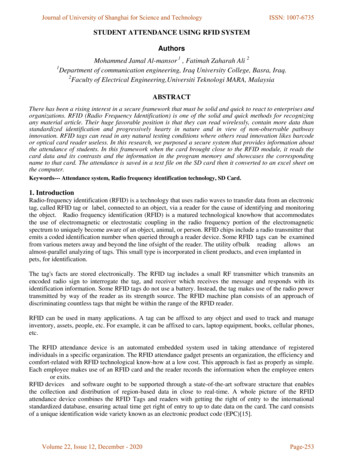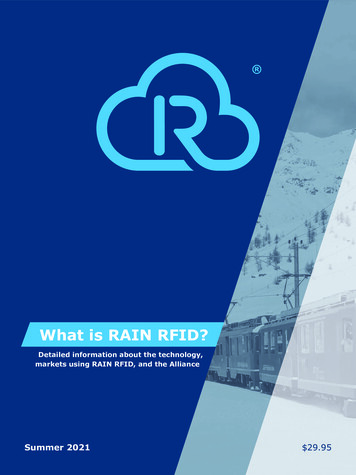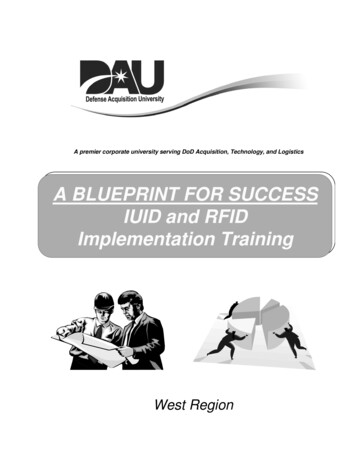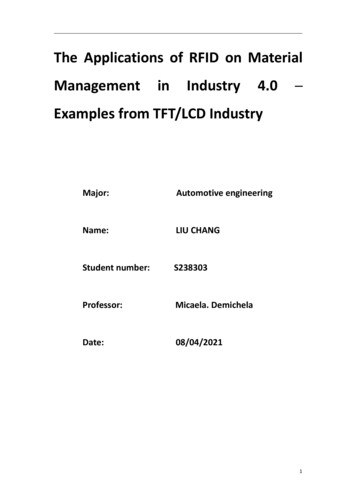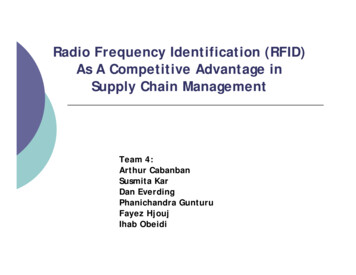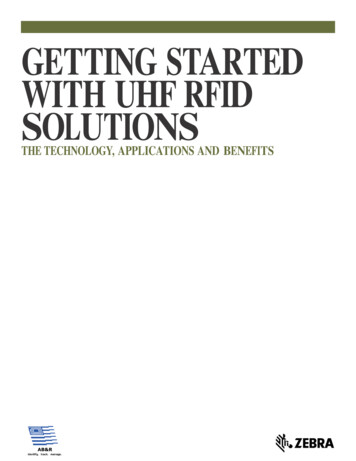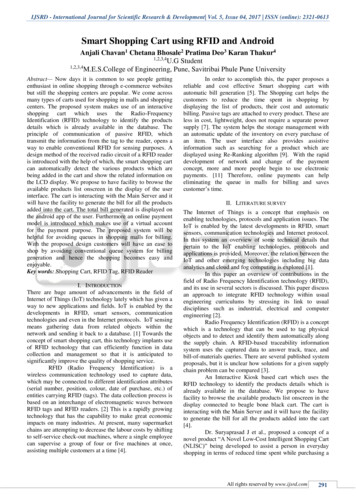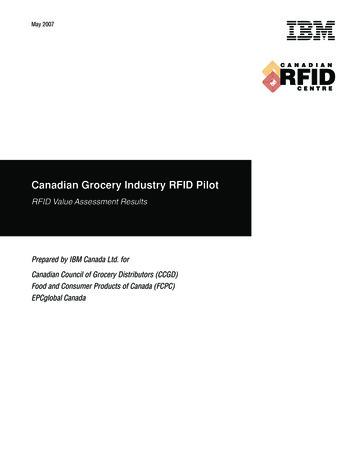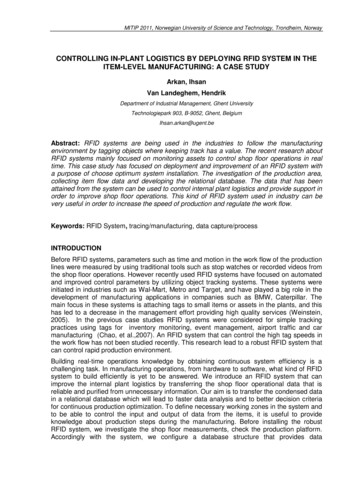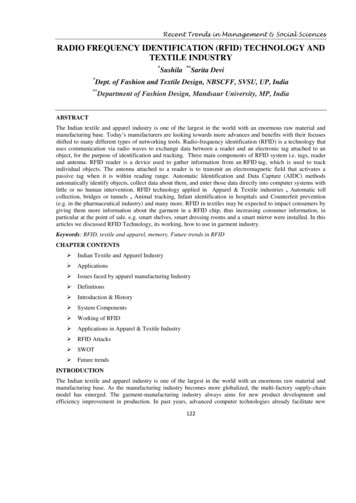
Transcription
Recent Trends in Management & Social SciencesRADIO FREQUENCY IDENTIFICATION (RFID) TECHNOLOGY ANDTEXTILE INDUSTRY**Sushila**Sarita DeviDept. of Fashion and Textile Design, NBSCFF, SVSU, UP, India**Department of Fashion Design, Mandsaur University, MP, IndiaABSTRACTThe Indian textile and apparel industry is one of the largest in the world with an enormous raw material andmanufacturing base. Today’s manufacturers are looking towards more advances and benefits with their focusesshifted to many different types of networking tools. Radio-frequency identification (RFID) is a technology thatuses communication via radio waves to exchange data between a reader and an electronic tag attached to anobject, for the purpose of identification and tracking. Three main components of RFID system i.e. tags, readerand antenna. RFID reader is a device used to gather information from an RFID tag, which is used to trackindividual objects. The antenna attached to a reader is to transmit an electromagnetic field that activates apassive tag when it is within reading range. Automatic Identification and Data Capture (AIDC) methodsautomatically identify objects, collect data about them, and enter those data directly into computer systems withlittle or no human intervention. RFID technology applied in Apparel & Textile industries , Automatic tollcollection, bridges or tunnels , Animal tracking, Infant identification in hospitals and Counterfeit prevention(e.g. in the pharmaceutical industry) and many more. RFID in textiles may be expected to impact consumers bygiving them more information about the garment in a RFID chip, thus increasing consumer information, inparticular at the point of sale. e.g. smart shelves, smart dressing rooms and a smart mirror were installed. In thisarticles we discussed RFID Technology, its working, how to use in garment industry.Keywords: RFID, textile and apparel, memory, Future trends in RFIDCHAPTER CONTENTS Indian Textile and Apparel Industry Applications Issues faced by apparel manufacturing Industry Definitions Introduction & History System Components Working of RFID Applications in Apparel & Textile Industry RFID Attacks SWOT Future trendsINTRODUCTIONThe Indian textile and apparel industry is one of the largest in the world with an enormous raw material andmanufacturing base. As the manufacturing industry becomes more globalized, the multi-factory supply-chainmodel has emerged. The garment-manufacturing industry always aims for new product development andefficiency improvement in production. In past years, advanced computer technologies already facilitate new122
Recent Trends in Management & Social Sciencesmanufacturing operation and build up management tools. Today’s manufacturers are looking towards moreadvances and benefits with their focuses shifted to many different types of networking tools. In past era peoplerecord the information of product to maintain a proper register. Then Barcode systems introduced in textileindustry due to advancement of technology, Using advanced technologies, which can reduce lead time, cost andmost importantly efficiently manage the inventory. But some drawback of Barcode system in which amount ofinformation stored in a barcode is very less as compared to RFID.APPLICATIONS1) Tracking cars, - access control, such as keyless entry and employee identification2) Apparel & Textile industries3) Automatic toll collection at the entrances to turnpikes, bridges or tunnels4) Animal tracking, with no need for physical capture, for instance in forests or mountain5) Vehicle tracking in cases of theft6) Infant identification in hospitals7) Controlling access to restricted areas8) Supply chain management9) Counterfeit prevention (e.g. in the pharmaceutical industry)APPAREL MANUFACTURING INDUSTRY: PROBLEM FACED Inaccurate & expensive Inventory management. Loss or theft of open goods accessible to customers. Out of stock which results into lost sale. Updating of the accurate information is difficult to manage & provide it for supply chain. Decreased productivity & unsatisfied customer service. Manual cycle count & waste of time. Missing shipments which impacts assortment on shelves. Difficult to track misplaced items.DEFINITIONRFID (radio frequency identification) is a technology that incorporates the use of electromagnetic orelectrostatic coupling in the radio frequency (RF) portion of the electromagnetic spectrum to uniquely identifyan object.Radio-frequency identification (RFID) is a technology that uses communication via radio waves to exchangedata between a reader and an electronic tag attached to an object, for the purpose of identification and tracking.Some tags can be read from several meters away and beyond the line of sight of the reader.123
Recent Trends in Management & Social SciencesHISTORY OF RFIDRFID in 1800- RFID’s source of energy comes from electromagnets. It is a microwaves hiss of energy. MichaelFaraday, an English experimentalist found in 1846 that both light and wave are the part of electromagneticenergy. Hertz was credited as the first to transmit and receive radio waves, in 1887. In 1896, Guglieimo Marconisuccessfully transmitted radio telegraphy across the Atlantic.Early 1900’s- Ernst F. W. Alexanderson demonstrated the 1 st transmission of radio waves signal, the beginningof modern radio, where all aspect of the radio wave were controlled. In 1922 , before world war II, the radar wasbeing invented.1940 through 1950- Radar refined and used. RFID was invented in 19481950 through 1960 -RFID technology was used for laboratory experiments1960 through 1970-development of the theory of RFID and start of applications for field trials.1970 through 1990 -RFID used for commercial application1990 through 2000 -Emergence of standards and RFID widely deployed.RFID System Components1. Tags (Transponders) Smart labels Reader/Interrogator Antenna Interface Host/Controller (PC/Laptop)RFID TagsRadio-Frequency Identification (RFID) is the use of radio waves to read and capture information stored on a tagattached to an object. A tag can be read from up to several feet away and does not need to be within direct lineof-sight of the reader to be tracked. The tag is also composed of a protective material that holds the piecestogether and shields them from various environmental conditions.Types of RFID tags1.Passive RFID tags:- which have no power source and require an external electromagnetic field toinitiate a signal transmission.2.Active RFID tags:-which contain a battery and can transmit signals once an external source('Interrogator') has been successfully identified.3.Battery assisted passive (BAP) RFID tags:- which require an external source to wake up but havesignificant higher forward link capability providing greater range.124
Recent Trends in Management & Social SciencesRFID tag memory1.Read-only tags -Tag ID is assigned at the factory during manufacturing, can never be changed and noadditional data can be assigned to the tag.2.Write once, read many (WORM) tags- Data written once, e.g., during packing or manufacturing, tag islocked once data is written, similar to a compact disc or DVD.3.Read/Write -Tag data can be changed over time, part or all of the data section can be locked.2. Smart labelsSmart labels differ from RFID tags in that they incorporate both RFID and barcode technologies. They’re madeup of adhesive label embedded with an RFID tag inlay, and they may also feature a barcode and/or other printedinformation.3. RFID readersRFID reader is a device used to gather information from an RFID tag, which is used to track individual objects.Radio waves are used to transfer data from the tag to a reader. RFID is a technology similar in theory to barcodesFunctions of Reader: Establish a bidirectional data link Communicate with networked server(s) Can read 100-300 tags per second–Readers (interrogators) can be at a fixed point such as-Entrance/exit and Point of sale4. AntennaThe antenna attached to a reader is to transmit an electromagnetic field that activates a passive tag when it iswithin reading range. Once a passive tag is activated it can transmit information from its antenna to that of thereader where it is processed. During rewriting applications the antenna of the reader acts as a relay device in thereverse direction, the reader communicates a message through its antenna, which transfers and stores the newdata to the activated transducer via its antenna.5. Interface: - is a device or program enabling to communicate with a computer.6. Host/Controller (PC/Laptop)-Computer with suitable software controls RFID readers125
Recent Trends in Management & Social SciencesWorking of RFID RFID belongs to a group of technologies referred to as Automatic Identification and Data Capture(AIDC). AIDC methods automatically identify objects, collect data about them, and enter those data directlyinto computer systems with little or no human intervention.Applications of RFID in Apparel & Textile1.Manufacturing process management system2.Inventory management3.Production control4.Tracking:a.Equipmentsb.Labor Movement5.Retail management6.Fitting room7.Product Distribution8.Sorting System9.Store Management10. Re-Stocking11. Checkout & Payment Process12. Promotion13. Care labeling1.Manufacturing process management systema) RFID Token – a low frequency (13.56MHz), passive tag with unique ID that is associated with a bundle ofcut- raw materials (i.e. sleeves, cuffs and hoods) that are to be used fulfill each order126
Recent Trends in Management & Social Sciencesb) RFID readers – installed in the cutting department next to each sewing machine and QC table. Readersattached to sewing machine is for reading data only and features simple button to inquire about previouslyscanned data, whereas that installed in the QC table has a key board on which the inspector input defectcode (e.g.0-low quality, 1-missing step,2-fabric problem, 3-size problem) after a particular piece of thegarment has been scanned and has the memory to store data of up to 3000 records in case of powershortage.c) PC workstation, which connects 40 sets of RFID readers in business structure. Data were collected to a PCworkstation before uploading to the computer server. Ethernet system which is used to transmit data fromPC station to server.2. INVENTORY MANAGEMENTThe use of RFID system assists in better inventory management and enhances customer shopping experienceindicate the type of clothing selling faster or slower, which provide customized advertisement on picked clothesaccording to the RFID tags.The received goods are registered and the data stored on RFID transponders can be read for each good thoughreceived in pallets or individual fashion item on hanger.3. PRODUCTION CONTROLInside the stores of the production department the stock level can be quickly monitored which helps in a realtime and efficient inventory management. The location and movement of the components, semi-finished andfinished products can be detected by the RFID system, which helps in production monitoring and control. Thishelps in improving the productivity and the quality. In the packing floor the mixing of different styles and sizescan be avoided by RFID tags. The number of pieces in packed cartons can be counted without opening, whichsaves the time and labour. Barburski et.al., (2008) stated that RFID technology can be used for the identificationand monitoring of a single product in textile factories. However, because of the harsh environment in textileproduction (high temperatures, chemicals, physical processing), RFID tags have to be properly packaged inorder to be protected from damage during the production process. RFID implementation new opportunities totracking the whole course of a product’s existence, from manufacturing and storing through to sale andutilization. Production and commerce companies both were significantly benefit from RFID applications.4. TRACKINGa). Equipment Tracking and Management The heavy equipments such as ginning machines, cotton cleaners, lap former, combers, as well asdrafting and drawing machines need to be routinely monitored and maintained. As they are large capitalinvestments are involved, it is important that the equipments are secure within the plant facility. Ifremoved from the zone or the facility, alerts will be sent to managers and security personnel to enableimmediate response. In addition to providing loss prevention, the Asset Tracking System also enables managers to program,maintenance schedules for each machine into the RFID Tags keeping equipment in optimum conditionensures maximum uptime for plant.b) Product tracking in spinning industryIn spinning industry it is used to avoid product mix, which is one of the prevailing problems faced in the qualitycontrol department. The areas such as carding, drawing and combing (sliver and hanks mix-up), simplex(bobbin mix-up), ring spinning (cop mix-up) can be avoided by placing the tag in the corresponding semifinished materials.c). Tracking of Labor MovementKnowing where an employee is at a particular time would allow the management to dispatch the closestqualified employee to a location requiring assistance. If an RFID reader detects an RFID-tagged employeeapproaching a security door, the door could be designed to open automatically. This would allow employees127
Recent Trends in Management & Social Sciencescarrying packages or carts to move more efficiently. This type of monitoring allow the management to know;whether employee spends excessive time in the break room or not getting enough break time. Reports could begenerated automatically to flag exceptions for management attention5. RETAIL MANAGEMENTIt is used in retail to monitor and control the floor level out-of-stocks. It is mostly required where there is highproduct display density, low staffing level and chances of mishandling is very high. The stock level of the itemsis properly maintained and the items can be grouped according to their demand. Mostly the retailers verify theaccuracy and integrity of the shipment by open-box audit prior to stocking or storing of goods. RFID provides anew horizon to the retailers in receiving materials, which eliminates the invoice disputes, mixing of differentquality products etc. Nikolicic et. al., (2015) conducted a study on impact of RFID technology on logisticprocess efficiency in retail supply chains. The research quantified the time reduction and related savings inlogistic process costs due to the application of RFID technology. The result found that the application of RFIDcontributes to costs reduction and business efficiency increase through the automation of the entrance and exitof goods, commissioning and operation of personnel. The utilization of RFID tags on packages can reduceprocessing costs by 26% and the total active time by 9%.a. Easy Product Accessibility in Retail Stores By using RFID, sellers can identify the exact location of any retail item at any time. Customer requestscan be handled quickly and easily by customer service team through access to a centralized database. RFID-tagged items offer store-to-store visibility, so items can be located immediately with the touch ofa button. This level of product accessibility results in shorter wait times for customers and offers abetter shopping experience. Improving overall store efficiencies ultimately results in greater savings tocustomers. With the help of RFID tags, it is possible to vary the items based on grades like A, B & C. (A-Costly,B-Moderate and C- Cheap). By the result obtained from the stock details, manager can give preferenceon ‘A’ and least on ‘C’. It will be more beneficial to spinning industry. By using RFID technology, retailers can collect information about their customers' purchasing trendsand offer rewards targeted to those interests. RFID can enable the marketing and customer serviceteams to identify customers, call up account histories, and provide value-added services to help create apersonalized shopping experience.Vlachos. (2006) evaluated that the impact of RFID practices on supply chain performance. RFID applicationsgrouped in two categories: location (supplier’s warehouse, retailer’s central warehouse, retailer’s localwarehouse, retailer’s owned stores) and utilization (standards, transportation, pallet level, specialised software).Factor analysis produced 7 supply chain performance factors: supplier, inventory, distribution, ordering, plan,sales, and forecasting. Empirical data were collected via an online survey administered to 300 retail companies.130 usable questionnaires were returned, for a 43.3% response rate. The results revealed that the implementationof RFID practices significantly affect the supply chain performance in the following areas: supplier, inventory,distribution, plan, sales, and forecasting. RFID can improve the performance of distribution systems, includingproducts dispatched and inventory in transit by 33.8% and stock availability by 45.6%.Elsheikh and Feky ., (2015) investigated the printed RFID technology and its deployment in the Egyptianfashion retailing, discovered the benefits and pointed out the barriers preventing the proper deployment of thistechnology in the Egyptian apparel retailing market. The results showed that using conventional electronicarticle surveillance (EAS) was not effective in securing store's goods, and it caused damage for about 0.05% ofgarments. An innovation in conductive ink allowed RFID tag providers to print RFID antenna on taggingsubstrates, instead of using a conventional solid-copper antenna, which was more expensive and less flexible. Inaddition to investigating the barriers limiting the deployment of RFID tags despite mentioned advantages, whichis according to interviews analysis, resulted in a full ignorance of RFID technology itself among apparel128
Recent Trends in Management & Social Sciencesretailers and Egyptian print houses, which require more research on the RFID marketing, and reduction ofprinted RFID tags' cost and the chips as well.Azevedo and Carvalho, (2012) studied the deployment of RFID technology in fashion supply chain management(FSCM). The logistics activities in the fashion supply chain where RFID technology is most widely deployedare: shipping operations, tracking of raw materials, semi‐finished components and finished garments, collectingfinished goods, handling processes, tracking containers, tracking products from factory to store, receivingoperations, monitoring, and sorting of merchandise. The main barrier identified to the deployment of RFID isthe problem of interoperability. The costs associated with the technology were the main disadvantage pointedout by the industries.6. FITTING ROOMRadio frequency identification technology is used in the fitting rooms. Automatic suggestions provided to men,buying clothes in the store when they go to a dressing room to try a suit. A ‘smart mirror’ informs that what kindof suit or accessories will be appropriate.An RFID reader on the smart mirror in the fitting room determines which clothing has been brought into theroom from the RFID tag attached to the apparel. The appropriate accessories are then displayed on a suitableinterface. This system is used in combination with ‘smart shelves’, which can read what merchandise iscurrently in stock, so that customers can be shown various styles and sizes that are available.Intelligent fitting roomRFID in textiles may be expected to impact consumers by giving them more information about the garment in aRFID chip, thus increasing consumer information, in particular at the point of sale. e.g. smart shelves, smartdressing rooms and a smart mirror were installed. These had the ability to read the RFID tag and give additionalinformation to the consumer, such as different sizes, colours, and types. Based on a customer survey, 56% saidthe intelligent shelf gave added value, 49% found the intelligent dressing room informative, and 33% felt theintelligent mirror was useful. Stuart (2016) conducted a study on RFID, an emerging wireless technology forsustainable customer centric operations. The study introduced an innovative RFID application that realized leanthinking in the presales service operations of an apparel retailer aimed at customer service excellence withimproved customer conversion rate and greener operations. Five practical issues were identified based on theinterview results: (i) ease of use, (ii) data privacy, (iii) cost advantage, (iv) compatibility, and (v) time to themarket.7.PRODUCT DISTRIBUTIONThe products are delivered in cartons or as hanger-goods as ordered by the stores, and transported withoutstorage at the logistics service provider. The distribution center staff equipped the goods with Serial ShippingContainer Code (SSCC) tags and brought them to the outgoing goods area. At the warehouse entrance ofdistribution center, RFID readers track the merchandise as it came in delivered products are registered,distinguishing stackable and hanger goods. The data stored on the RFID transponders are read automatically foreach individual product.129
Recent Trends in Management & Social Sciences8. SORTING SYSTEMHanger and stackable-good shipments with RFID transponders arrived from the distribution center and passedthrough the incoming goods portals of the stores. Staff scans the RFID transponders on the Serial ShippingContainer Code (SSCC) tags with a mobile RFID reader. The data is automatically entered into a centraldatabase and then compared to the values in the merchandise management system, a computer-aidedinformation system to register and manage goods based on amount and value.9.STORE MANAGEMENTIntelligent Clothes Racks are equipped with an RFID antenna. The moment the article was returned was, alsoregistered. The time that lapsed before a customer returned an item to the rack, provides valuable information: Ifa customer put a blouse back on the clothes rack after five seconds, she possibly did not like the material. If fiveminutes went by, it is likely that the customer tried on the article. Smart Shelves offers similar functionalities forstacked goods.10. RE-STOCKINGProducts are monitored to ensure that they remain stocked at appropriate levels. When they fall below that level,an alert is sent to the stockroom or office to bring out or order more merchandise. For stores with stockrooms,RFID monitoring alerts employees when stock levels reach the threshold. Depending on how the system isconfigured, re-orders may be done automatically for items that the store plans to continue selling: If many blacktrousers of waist 32-size are being sold and are getting out of stock, RFID can send an alarm to order more suchtrousers from the storeroom.11.CHECKOUT & PAYMENT PROCESSSelected cash registers are equipped with RFID readers and connected to the merchandise management system.In order to complete the checkout and payment process, staff merely places the fashion goods onto the cashdesk. The total amount to be paid displayed at the cash register, customers then continue the check out withtraditional payment procedures (credit card, cash, etc.).12. PROMOTION & SALEWith RFID on loyalty cards to identify the customer, and a customer shopping-history database, items could bepriced differently depending on the characteristics of the shopper (eg, special promotions for first-time shoppersand rewards for frequent shoppers). Different promotions could be offered to different customers via theirpersonal digital assistants or cell phone displays, at kiosks (Information Booth), and by employees receivingprompts on their point-of-sale terminals. Additionally, if customers have submitted their profiles to the store,they could be reminded of upcoming events such as birthdays, and have purchases suggested to them. These canbe added on to the loyalty cards which already exist at places like Shopper’s Stop, Wills Lifestyle, etc13.CARE LABELINGThe electronic labels use RFID tags for storing information electronically on a garment. Additional tags areneeded for the wash care instructions, which will increase the cost of the garment. In addition, the consumersneed special readers to extract the information stored in the RFID tag. Wang et.al., (2015) studied the impact ofwashing on epoxy-coated copper fabric textile RFID tags. Tag samples were washed in a household washingmachine, in a 40 C washing program with detergent and spinning, and tested wirelessly after each washingcycle. The epoxy-coated tags achieved attainable peak read ranges of approximately 8 meters. The tagsmaintained read ranges of 7meters after 15wash repetitions, which was very promising for future wearableapplications. However, strong mechanical stress during washing and spinning was found to cause a majordamaging impact on tag performance.RFID attacks1.High cost2.Tag damage- due to the improper handling of the material130
Recent Trends in Management & Social Sciences3.Fake tags- The attackers may replace the original tags with fake ones, which will prevent the datatransfer or provide fake information to the reader.4.Security attacks- The attackers can break the security algorithm used in the RFID system or modifythe message in the reader.5.Compatibility- RFID may not be compatible with some existing technologies and even if it can beintegrated with existing system the expectancy of 100% data accuracy is still a matter of concern.6.Technology- The use of RFID readers to read the price tags of purchased merchandise at the checkoutcounters may be interfered by radio waves from other merchandise. In addition, the merchandise aremade in different countries and may be packed with different material7.Lack of standardization- standards such as EPC class 1 and ISO 18000-6 are being released, both thestandards are yet not finalised and lack compatibility with each other.The other concern related to the use of RFID tag is the electronic waste. An appropriate method should bedevised to recycle or reuse the RFID tags, if they are removed at the point of sale. Similarly, if customersremove the chip at some point, proper disposal of the tags is essential, which causes additional worries to thecompanies. Hingley, et. al., (2007) stated that retailers deployed RFID enjoy reduced labor costs. The mainobstacles identified by companies for not using this technology were the high costs. The RFID tag and systemcost was high, but positive returns were obtained from the continuous material flow. Liu et. al., (2009) revealedthat the environment, organization, technology and product have the impact on the adoption of RFID in China.An increasing number and a wide variety of enterprises employed RFID to improve the efficiency of theiroperations and to gain a competitive advantage. It was stated that implementation of RFID, enterprises willhave to resolve issues of technology development, international standards and regulations, and costs. If theseissues are addressed, it is certain that RFID will continue to innovate and diffuse and that it will quickly beassimilated into daily lives. RFID SWOTStrengths Advanced technology Easy to use High memory capacity Small sizeWeaknesses Lack of industry and application standards High cost per unit and high RFID systemintegration costs Weak market understanding of the benefits ofRFID technologyOpportunities Could replace the bar code End-user demand for RFID systems is increasing Huge market potential in many businessesThreats Ethical threats concerning privacy life Highly fragmented competitive environmentKnezevic et. al., (2015) stated that RFID technology is one of the rapidly growing technologies with a hugepotential of application in retail supply chain. RFID technology can have enormous positive impact on businessprocesses in supply chains: (1) it reduces overhead costs by improving shipping and receiving procedures andby eliminating the human error out of supply chain administration activities,(2) business forecasting in the fieldof inventories ,(3) shelf stocking and in store product replenishment is becoming more efficient,(4) stocks isapplying the real-time quantities, (5) smart label improve automatic identification in warehouses. The increasingapplication of RFID will affect the RFID tag price reduction and enable the implementation of this technologyon consumer goods. The aim of introducing RFID technology in retail is to reduce costs, increase customersatisfaction, which would result in increased profitability of enterprises. Koh et.al., (2016) studied the RadioFrequency Identification (RFID) and postulates a structural causal relationship among its intrinsic attributes,perceptions, and impact on business performance. Four major categories of RFID benefits were identified: (a)improved inventory management, (b) velocity of retail cycle, (c) integrated business model, and (d) efficiency ofstore operation. In addition, three major risk factors were recognized: (a) lack of technical expertise, (b)131
Recent Trends in Management & Social Sciencescomplexity of the technology, and (c) uncertainty of the technology. From the structural causal relationshipanalysis, a significant relationship was found between intrinsic attributes and benefits of RFID, but theconnection between intrinsic attributes and risks of RFID was not substantiated. In particular, two RFID benefitfactors, velocity of retail cycle and improved inventory management, seem to have a strong effect on business.Future trends in RFID The use of RFID technology for individual identification of garment pieces, or packages of garmentcan be used to support more direct delivery of garment from production plants to retailers. This caneliminate the need to root them by default through supplier, warehouses for order –specific picking.Direct delivery requires more flexible allocation of articles to customer order in apparel supply chains,which have to
Recent Trends in Management & Social Sciences 125 RFID tag memory 1. Read-only tags-Tag ID is assigned at the factory during manufacturing, can never be changed and no additional data can be assigned to the tag. 2. Write once, read many (WORM) tags-Data written once, e.g., during packing or manufacturing, tag is locked once data is written, similar to a compact disc or DVD.

